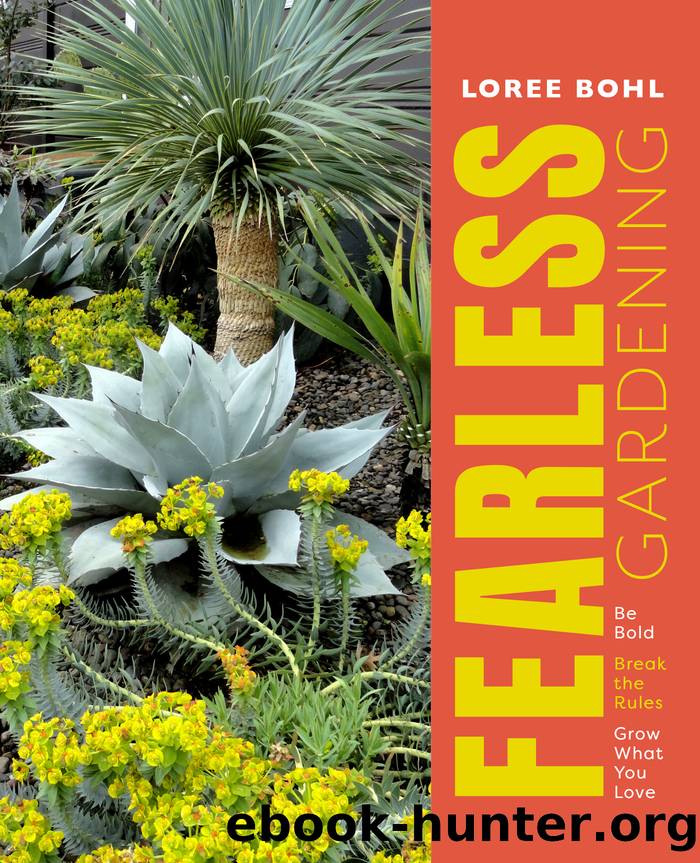Fearless Gardening by Loree Bohl

Author:Loree Bohl
Language: eng
Format: epub
Publisher: Timber Press
Published: 2021-01-15T00:00:00+00:00
Passiflora âSunburstâ, a zone 10 plant. Or is it?
Plants donât read labels, or maybe itâs more accurate to say plants canât talk, so they arenât able to tell us low they can go. Hardiness ratings for many of the plants we buy are simply educated guesses based on the experience of nurseries and growers whoâve trialed them and observed how theyâve done. Assumptions are made based on similar plants and where plants (or their parents) are found growing in the wild. As my friend Janet Sluis, director of the Sunset Western Garden Collection, points out: there are numerous new plant varieties from frost-free climates being introduced to the market. We assume these plants canât take a frost, but are we right? She also warns, âWith so much hybridization going on, you never really know what parental genes (so to speak) are going to come through.â Itâs true, you never really know!
Case in point: I fell hard for an orange passionflower, Passiflora âSunburstâ, snatching it up as soon as I laid eyes on it. The nursery had it listed as a zone 10 plantâtwo zones warmer than my gardenâbut I was so spellbound that I didnât care. That plant bloomed like crazy its first year in my garden, so when temperatures dropped that autumn I dug it out, potted it up, and put it in the basement, hoping it would overwinter there. Sure enough, when planted out the next spring, it took off as though it had never been on hold. But it gets even better! I must have left a bit of the plant behind when I dug it up, because it also reappeared in its original spot that spring. In fact, it has come back every year since, even surviving temperatures in the teens. Is the plant hardier than its listed zone? Or did I get lucky and happen to plant it in a magical microclimate? Likely a combination of both, as this example shows plant hardiness ratings are not an exact science. Experimenting with what you plant and pushing your USDA zone can yield very exciting, and yes, at times, disappointing results. Remember, killing plants is part of gardening on the fearless side.
Itâs also worth noting that the reverse can happen. Sometimes those responsible for writing plant labels err on the side of being overly generous when describing the low temperatures a plant will survive. Maybe theyâre working with inaccurate information, orâpossiblyâbeing a little unscrupulous and hoping to sell more plants. Whatever the case, itâs best to treat the information on a label as a guideline only, not fact. Talk with like-minded gardeners in your area and compare notes on how borderline plants do in your gardens. Then celebrate your successes and learn from your failures.
Download
This site does not store any files on its server. We only index and link to content provided by other sites. Please contact the content providers to delete copyright contents if any and email us, we'll remove relevant links or contents immediately.
On Writing A Memoir of the Craft by Stephen King(4848)
The Doodle Revolution by Sunni Brown(4668)
A Simplified Life by Emily Ley(4080)
Mummy Knew by Lisa James(3620)
Marijuana Grower's Handbook by Ed Rosenthal(3606)
Better Homes and Gardens New Cookbook by Better Homes & Gardens(3509)
Figure Drawing for Artists by Steve Huston(3362)
Paper Parties by Erin Hung(3354)
Draw Your Day by Samantha Dion Baker(3258)
The Genius of Japanese Carpentry by Azby Brown(3209)
Japanese Design by Patricia J. Graham(3098)
The Code Book by Simon Singh(3057)
Dangerous Girls by Haas Abigail(2956)
Lions and Lace by Meagan Mckinney(2911)
The Curated Closet by Anuschka Rees(2897)
How to Make Your Own Soap by Sally Hornsey(2812)
The Checklist Manifesto by Atul Gawande(2763)
The Wardrobe Wakeup by Lois Joy Johnson(2717)
Zero to Make by David Lang(2716)
